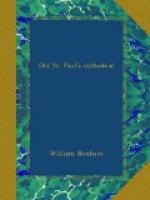Crossing the Choir, and beginning from the west, we will now proceed eastward along the South Aisle of the Choir. First, we come to two famous Deans, Donne and Colet, the account of whom belongs to a subsequent page. In fact, the greater number of monuments in this aisle are of later date than the others, but it will be more convenient to take them here, excepting those which are connected with the subsequent history. The wall monument of WILLIAM HEWIT (arms, a fesse engrailed between three owls) had a recumbent figure of him in a layman’s gown. He died in 1599.
SIR WILLIAM COKAYNE (d. 1626) was a very rich Lord Mayor; high in the confidence of James I., who constantly consulted him on business. He was a munificent contributor to good works. It was said of him that “his spreading boughs gave shelter to some of the goodliest families in England.” From his daughters descended the Earls of Nottingham, Pomfret, Holderness, Mulgrave, and Dover; the Duke of Ancaster, and the Viscounts Fanshawe.
JOHN NEWCOURT, Dean of Auckland, Canon of St. Paul’s, Doctor of Law (d. 1485).
The handsome brass of ROGER BRABAZON, Canon of St. Paul’s (d. 1498), had a figure in a cope. At the foot was the scroll, “Nunc Christe, te petimus, miserere quaesumus: Qui venisti redimere perditos, noli damnare redemptos.”
Passing into the south side of the Lady Chapel, we come to two more mediaeval Bishops of London: HENRY WENGHAM (1259-1262). He was Chancellor to Henry III. Close to him was EUSTACE FAUCONBRIDGE, a Royal Justiciary, and afterwards High Treasurer, and Bishop of London, 1221-1228.
WILLIAM RYTHYN, LL.D., was Rector of St. Faith’s and Minor Canon of the Cathedral (d. 1400).
RICHARD LYCHFIELD, Archdeacon both of Middlesex and of Bath, Canon Residentiary of St. Paul’s (d. 1496).
The tomb of SIR NICHOLAS BACON (1509-1579), Queen Elizabeth’s famous minister, and father of the great philosopher, had his recumbent figure, and those of his two wives, Jane, daughter of William Fernley, and Ann, daughter of Sir Anthony Cooke. The latter was the mother of Francis. The Latin inscription on the tomb was most laudatory, and reads as if it came from the same pen that wrote the dedication of the Advancement of Learning.
Another of the Elizabethan worthies is SIR FRANCIS WALSINGHAM (d. April 6th, 1590). The monument to him was placed on the wall, with a long Latin biographical inscription and twenty lines of English verse.
Two other wall tablets in the same chapel commemorated other heroes of that period. SIR PHILIP SIDNEY, who died of his wound at Arnhem, October 15th, 1586, was buried in St. Paul’s, with signs of public grief almost unparalleled. “It was accounted sin for months afterwards for any gentleman to appear in London streets in gay apparel.” The tablet to him was of wood, and bore the following inscription:—




